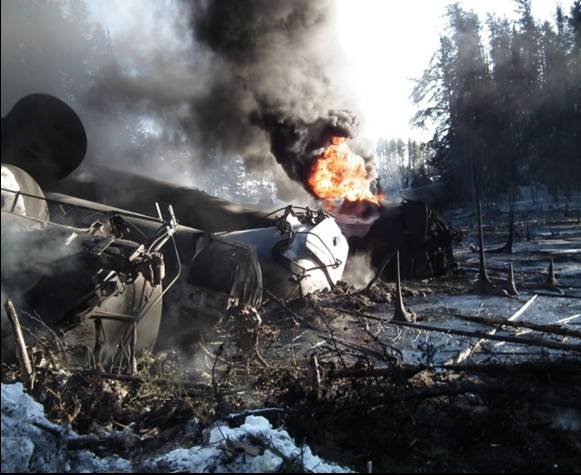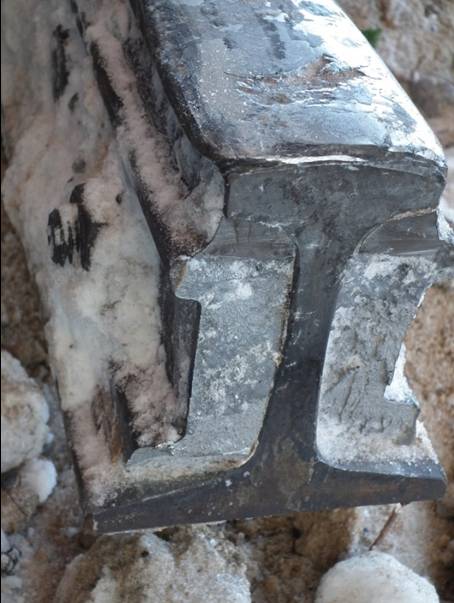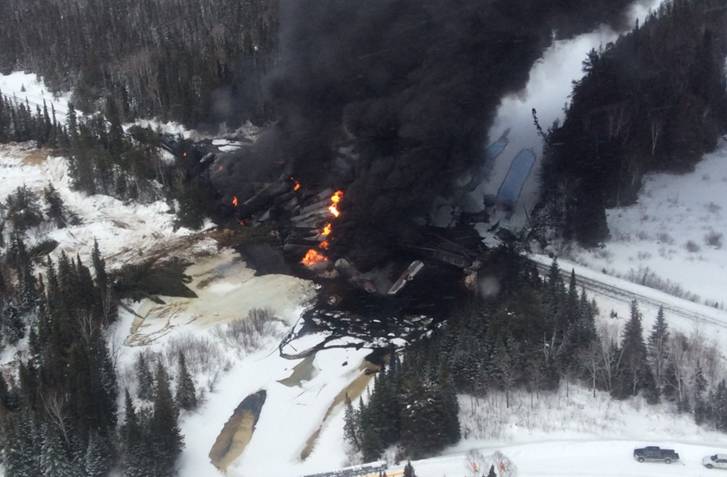Place du Centre
4th Floor
200 Promenade du Portage
Gatineau, Quebec
K1A 1K8
17 March 2015
617-04/15
R15H0021
Letter addressed to Transport Canada
SUBJECT:
Rail transportation safety advisory letter – 04/15
Condition of Track Infrastructure on CN Ruel Subdivision
Between 14 February 2015 and 07 March 2015, 3 significant train derailments occurred on Canadian National’s (CN) Ruel Subdivision in Northern Ontario. In each of these accidents, the derailed cars included Class 111 tank cars that were compliant with the CPC-1232 tank car standard. The accidents are summarized as follows:
On 14 February 2015, Canadian National (CN) crude oil unit train U70451-10 was proceeding eastward on CN’s Ruel Subdivision near Gogama, Ontario. The train was equipped with 2 head-end locomotives hauling 100 Class 111 tank cars. There were 68 cars loaded with Petroleum Crude Oil (UN 1267) and 32 cars loaded with Petroleum Distillates (UN 1268). The train was 6089 feet long and weighed 14 355 tons. The train was designated as a “Key Train”Footnote 1 operating on a “Key Route”.Footnote 2
At 2350 Eastern Standard Time (EST), while travelling at 38 mph, a train-initiated emergency brake application occurred near Mile 111.6. Looking back, the crew members observed a fire about 10 cars behind the locomotives, so they detached the locomotives from the train. The temperature at the time was −31°C and a 40 mph slow order was in place.
The 7th to the 35th cars behind the locomotives (29 cars in total) had derailed. During the derailment and subsequent fire, at least 19 tank cars were breached or partially breached and released various amounts of product. Five of the 19 cars exhibited thermal tears (Photo 1). A total of 21 cars sustained fire damage ranging from minor to severe. It is estimated that over 1 million litres of product was released, either to the atmosphere or to the ground. About 900 feet of track was destroyed. (TSB Occurrence No. R15H0013)
During site examination, the TSB recovered a section of broken rail containing a failed insulated rail joint that likely played a role in the accident (Photo 2). The rail components were sent to the TSB Laboratory for further analysis.
On 05 March 2015, CN’s mixed manifest train X30131-04 was proceeding eastward on CN’s Ruel Subdivision near Minnipuka, Ontario. The train was equipped with 2 head-end locomotives hauling 7 loaded cars, 75 empty cars and 19 residue Class 111 tank cars. The train was 6059 feet long, weighed 4075 tons and was operating on a “Key Route”.
At about 0630 EST, a train-initiated emergency brake application occurred near Mile 239.94. Subsequent inspection revealed that the 71st to the 86th cars behind the locomotives had derailed. The 16 derailed cars included 13 residue Class 111 tank cars that last contained Petroleum Crude Oil (UN 1267) and 3 residue Class 111 tank cars that last contained Gasoline (UN 1203). Although 2 of the tank cars were reportedly punctured, no release of product was reported. There were no injuries and no evacuation was required. The temperature at the time was -27°C. (TSB Occurrence No. R15H0020)
Preliminary indications are that the point of derailment was at a broken rail that contained a vertical split head (VSH) defect. The broken rail was sent to the TSB Laboratory for further analysis.
On 07 March 2015, CN crude oil unit train U70451-02 was proceeding eastward on CN’s Ruel Subdivision near Gogama, Ontario. The train was equipped with 2 head-end locomotives hauling 94 Class 111 tank cars loaded with Petroleum Crude Oil (UN 1267). The train was 6089 feet long and weighed 14 355 tons. The train was designated as a “Key Train” operating on a “Key Route”.
At 0242 EST, while travelling at 43 mph, a train-initiated emergency brake application occurred near Mile 88.70, in the vicinity of the CN rail bridge that traversed the Makami River. Looking back, the crew members observed a fire about 700 feet behind the locomotives. They detached the locomotives and first 5 cars behind the locomotives from the derailed cars and pulled clear. The temperature at the time was about -10°C.
Site examination revealed that the 6th to the 44th cars behind the locomotives (39 cars in total) had derailed (Photo 3).
The 6th and 7th cars derailed to the south, but had made it across the bridge to the east side of the river. The 43rd and 44th cars derailed, but remained upright and came to rest near Mile 88.75 on the west side of the river. The remaining cars derailed near the west end of the bridge. Two of the cars were submerged in the river, 3 cars were partially in the river and the rest were in a pile on the west river bank. A number of the cars were breached, released product and ignited a large pool fire that destroyed the steel rail bridge. Most of the remaining cars sustained fire damage ranging from minor to severe. At least 5 of the 34 cars exhibited thermal tears. About 700 feet of track was destroyed. (TSB Occurrence No. R15H0021)
While firefighters dealt with the fire, TSB investigators examined the area at the west end of the bridge and recovered a section of broken rail within a plug rail joint that had been installed 2 days prior to the accident (Photo 4). The plug rail was put in place as a repair for an in-service thermite weld failure identified previously at that location. The recovered rail components were sent to the TSB Laboratory for further analysis.
The CN Ruel Subdivision consists of single main track that extends westward from Capreol, Ontario (Mile 0.00), to Hornepayne, Ontario (Mile 296.20). Train movements on the subdivision are governed by the Centralized Traffic Control System (CTC), as authorized by the Transport Canada−approved Canadian Rail Operating Rules and supervised by a rail traffic controller located in Toronto, Ontario.
The single mainline track consists primarily of continuous welded rail (CWR) and is rated as Class 4 track under the Transport Canada−approved Track Safety Rules. Class 4 track permits track speeds of up to 60 mph for freight trains and 80 mph for passenger trains. However, there were permanent slow orders on much of the subdivision to protect against various infrastructure and track maintenance issues.
Preliminary indications are that track infrastructure failures may have played a role in each of the 3 accidents. For the 2 Gogama accidents that involved CN unit trains hauling Class 111 tank cars loaded with flammable liquids, a total of 68 cars derailed in the vicinity of a broken rail. Although the tank car damage observed was significant, the loss of containment and ensuing fires occurred as a result of the accident. While a more robust tank car may have reduced the severity of these accidents, it would not have addressed any infrastructure-related issues.
Petroleum crude oil unit trains with heavily loaded tank cars will tend to impart higher-than-usual forces to the track infrastructure during their operation. These higher forces expose any weaknesses that may be present in the track structure, making the track more susceptible to failure. To help mitigate these risks, following the Lac-Mégantic investigation, the TSB recommended that:
The Department of Transport set stringent criteria for the operation of trains carrying dangerous goods, and require railway companies to conduct route planning and analysis as well as perform periodic risk assessments to ensure that risk control measures work.
Transportation Safety Recommendation R14-02
While the proposed design changes for tank cars that transport Class 3 flammable liquids are a positive development for the long term, flammable liquids will continue to be transported in Class 111 tank cars in the short term. Consequently, more needs to be done to ensure safety when flammable liquids are being transported by “Key Trains” on “Key Routes.”
Permanent slow orders had already been put in place on CN’s Ruel Subdivision to protect against various infrastructure and maintenance issues. All 3 derailments on this subdivision occurred within a short period of time and each involved a track infrastructure failure. Given the potential damage and consequences of a train derailment, particularly when petroleum crude oil unit trains are involved, Transport Canada should review the risk assessments conducted for the Ruel Subdivision, assess the track infrastructure condition and determine whether additional risk control measures are required when operating a ”Key Train” on this “Key Route”.
Yours sincerely,
Original signed by
Kirby Jang
Director
Investigation Operations, Rail/Pipeline
Cc:
- Canadian National
- VIA Rail
- Railway Association of Canada



